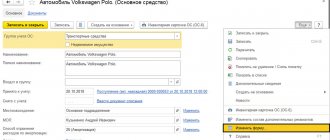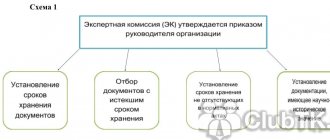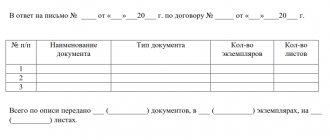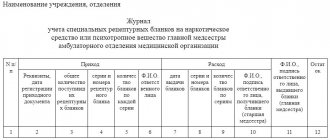The concept of the nomenclature of an organization’s affairs
The nomenclature of affairs is a register that allows you to systematize all documents used in the activities of the organization.
This is achieved by grouping them into cases formed thematically, taking into account storage periods. The list of such cases, drawn up in a certain form, is their nomenclature (clause 94 of GOST R 7.0.8-2013). The use of nomenclature in relation to current documents solves several problems, such as:
- classification and accounting;
- easier search;
- assistance in transferring cases and drawing up inventories;
- systematic preparation for selection for further storage and destruction.
The list of cases can be:
- standard (normative), developed by the department and accepted by subordinate organizations as a model when drawing up their own document;
- exemplary or recommended, i.e. serving as a methodological guide for creating nomenclature in similar organizations related, for example, to the same industry;
- individual, developed for a specific organization.
Find out how to create a list of accounting affairs in ConsultantPlus. To do everything correctly, get trial access to the system and go to the Ready solution. It's free.
Nomenclature goals. Its compiler
What is this to-do list for? The compilation of nomenclature pursues the following goals:
- Systematize all company affairs.
- Have the opportunity to present a document when necessary.
- Possibility of preserving the original for a certain storage period.
Thus, nomenclature brings enormous benefits to any organization.
One of two departments is responsible for compiling a list of all cases:
- Office. This department undertakes the compilation and development of the list only in the case of large production. For example, a huge factory or supermarket.
- Secretariat. This department deals with nomenclature work in case of small production. For example, a school or a store.
Responsibility for using nomenclature
Organizations that transfer documents to the state archive are required to compile a list of files (clause 2 of Article 20 of the Law “On Archival Affairs in the Russian Federation” dated October 22, 2004 No. 125-FZ, introductory part of the Basic Rules for the Operation of Archives of Organizations, approved by the decision of the Rosarkhiv Board of February 6, 2002 ):
- state and municipal;
- non-state in terms of documents classified as state property;
- non-state, if they have concluded an agreement with the state archive.
Other legal entities have no obligation to draw up nomenclature. But it should be borne in mind that in the event of liquidation of a non-governmental organization, its documents are submitted to the state archive (Clause 10, Article 23 of Law No. 125-FZ), and in this case a list of files will be needed.
In addition, non-governmental organizations must store archival documents for the established storage periods (Clause 1, Article 17 of Law No. 125-FZ), i.e., create their own archives. It is more convenient to create such an archive according to the current rules approved by Rosarkhiv. Having a list of cases drawn up according to these rules will not only help a legal entity in recording documents, working with them, storing and destroying them, but will also facilitate the transfer of cases to another organization in the event of reorganization or to the state archive in case of liquidation.
How to liquidate an organization, read our articles:
- “Liquidation of a joint stock company - step-by-step instructions”;
- “The procedure for closing an LLC - step-by-step instructions.”
Read about drawing up a liquidation balance sheet in the article “Liquidation balance sheet - an example of a zero balance sheet according to the new form.”
Nomenclature
— the name of the accounting unit for inventories and services of the organization.
The directory of the same name in the accounting products of the company 1c is an analytical section for accounts that take into account inventories, construction projects, and equipment. Participates in filling out documents related to accounting for services and inventories.
Find what Nomenclature
in
Yandex
search engine ...
Find what Nomenclature
in
Google
search ...
Word forms:
nomenclature, nomenclature, nomenclature, nomenclature
services, accountant, document, assembling of items, disassembly of items, reusable packaging, organization, accounting, accounting, inventories, MPZ, PBU 05/2012
services, accountant, document, assembling of items, disassembly of items, reusable packaging, organization, accounting, accounting, inventories, MPZ, PBU 05/2012
See also Nomenclature related terms:
Accountant
Accounting Document Assembling of items Reusable containers MPZ Organization PBU 05/2012 Disassembly of items Services Accounting
See also related articles:
A completely new edition of the 1c:Accounting configuration edition 3.0
See also related questions and answers:
Where in 1c:Accounting can you specify the article number for a product?
comments powered by
Other definitions starting with " N"
«:
Reliable counterparty
Name of organization Invoice Cash Cash Cash Cash payment Tax Value added tax Individual income tax Property tax Real estate tax Income Transport tax Tax base return inspection Tax authorities Tax Code tax consultant Tax period Profit taxation Taxpayer Setting up 1c Head of HR Department Accrued wages VAT Personal Non-automated retail outlet Unclaimed dividends Real estate Real estate Arrears Shortage Hostile takeover Work in progress Unfinished production Unfinished construction illegal business activity Illegal entrepreneurship Unspent advance amounts Illiquid asset Illiquid Unreliable counterparty Ambiguity in the interpretation of legal norms Non-operative Posting of documents Unposted documents Undistributed profit Minimum balance Insolvency Insolvent Incapacity WIP Below cost Low- Downtrend Intangible assets , intangible assets Standardized expenses NTT Zero reporting Zero balance Zero budget New York Stock Exchange
You found out what Nomenclature is
.
In our accountant dictionary
there are 1,195
accounting terms and definitions
.
If you have not found an accounting term
, then you can send us a request for its inclusion in our dictionary!
We would also like to note that the dictionary is constantly being updated... and if you have not found what you are looking for today, there is a chance that you will find the information you are looking for later!
The procedure for the formation and approval of nomenclature
The list of cases is compiled by each legal entity individually for itself. In those organizations that must use its standard form, the work is facilitated by the fact that the names of cases and deadlines from these forms are transferred to their document. Development is usually entrusted to an in-house department or employee. However, you can also involve a third-party organization or resort to the help of Rosarkhiv (clause 3.4.2 of the Basic Rules for the Operation of Archives).
The nomenclature is based on all documents characterizing the features of the activities and structure of a legal entity, previous nomenclatures, as well as lists of standard documents generated in the activities of organizations. In legal entities that have structural divisions (including separate ones), it is first developed in relation to each division, and then consolidated into a single register.
Before approval, the nomenclature of files is agreed upon with an employee of the own archival service and an expert commission (EC), which is entrusted with the functions of assessing the significance of documents, and when submitted to the state archive, with its expert verification commission (EPC). The agreed document is approved by the head of the organization and put into effect by order.
For the first time, the nomenclature of cases is developed at the beginning of the legal entity’s activities, and then it is reviewed annually at the end of the year and begins to be applied in a refined version from the beginning of the new year (clause 3.4.6 of the Basic Rules for the Operation of Archives). The 1st order on nomenclature also recommends approving the procedure for storing current affairs, which may vary.
Revision and clarification of the nomenclature of HR department affairs
The list of cases of the unit, indicated in the nomenclature of cases, was relevant a year ago. Over the past months, he could have remained the same, or he could have changed. The organization develops, and its business processes develop, gradually and inevitably changing. The HR department is no exception.
It is possible that during the year the emergence of new cases in the unit was not noticeable. And if you look closely, it turns out that a new counterparty has appeared with whom there is active correspondence, the municipal department that “issued” the orders was renamed, and one of the employees came up with a registration form, which the entire department now cannot do without. In addition to the usual business processes, these changes are reflected in the nomenclature of cases. They need, firstly, to be detected, and secondly, to be taken into account when compiling a list of cases for the next calendar year.
The annual clarification of the nomenclature of cases is:
- detection of cases opened during the year and entering them into the current list of cases;
- discovering cases that will not be pursued next year.
As a result of studying the documents of the department and clarifying the nomenclature, it turns out that, for example, during 2015, new cases were opened in the personnel department (example 3):
Example 3. New cases that should be included in the list of cases for the next year
and the following cases are excluded from the list of cases for 2021:
- 24-21 “Correspondence with Advokat LLC on operational issues of legal support for personnel management activities”;
- 24-25.01 “Documents in case No. B36-448093/2014 (Kasimova R. A.)”;
- 24-25.02 “Documents on case No. B36-468965/2014 (Demidov M. S.).”
The information received will be taken into account when drawing up the nomenclature of cases for the next year, and on its basis, current changes will be made to the current nomenclature.
We are making changes to the current nomenclature of cases
When compiling a list of cases for the next year, we strongly recommend leaving space in the document for adding new cases opened during the year (see example 2). Blank lines are left from three to five at the end of the section and, if necessary, filled in by hand in all copies of the current nomenclature (example 4). New cases are indexed in gross numbering order.
Example 4. Making changes to the current nomenclature of cases (fragment)
Of course, such changes need to be made in real time: months should not pass between the opening of a case in a department and the addition of the list of cases. But, as practice shows, this is usually forgotten.
Pay attention!
If changes in the nomenclature of cases that occurred during the year relate only to the termination, “closing” of cases, there is no need to make any deletions or notes in the document.
What are carryover cases?
Headings of cases on issues not resolved within one year are transferable and are included in the list of cases of the organization for the next year with the same index (clause 3.4.9 of the Basic Rules).
For example , if in 2015 an organization got involved in a legal battle with a former employee, which will obviously continue in 2016, then the case in which documents on this issue are placed will be transferable. And if in 2015 it was assigned the index 24-25.03, then it will remain so until the court makes a final decision.
If the organization has a new department
If during the year there are changes in the staffing structure of the organization and a new department appears, the composition of its affairs should be included in the consolidated nomenclature. To do this, at the end of the document, a sheet with a blank table is specially left, which is filled out by hand. The new division receives the next (extreme) serial number in the nomenclature of cases of the year in which it was created. Perhaps in the list of cases for next year the section will move according to the logic of the enterprise's staffing structure.
For example , in mid-2015, the labor and wages department was separated from the personnel department into an independent structural unit. It will be included in the consolidated nomenclature of cases for 2015 under number 36, provided that before that there were 35 sections in the document. And in the nomenclature of cases for 2021, the section “Labor and Wages Department” will appear after the section “Human Resources Department” and will receive a serial number of 25. In this case, the numbering of all subsequent sections will move forward by one digit, and if there were transferable cases in these sections, then their indexes will change. This is acceptable. In such cases, transitional cases are marked with Fr.
Conclusions:
- The list of cases is updated and re-approved annually. This work should begin in the fourth quarter of the year and be completed by the end of December.
- Clarifying the nomenclature of cases means collecting information about cases that:
- reopened in the past year;
- will not be conducted in the unit next year.
- If cases are discovered that were opened during the year and are not reflected in the current nomenclature of cases, they are entered into the current nomenclature of cases by hand in the lines specially left for this purpose.
print version
Structure of the nomenclature of cases
The nomenclature of files is a table, the forms of which are given in Appendices 7 (main document) and 8 (compiled by a structural unit) to the Basic Rules for the Operation of Archives. The differences between these forms lie in their names and set of signatures.
The main (tabular) part of the document consists of 5 columns:
- The case index is its number.
- The title of the case is its name.
- Number of storage units - the number of folders in one title. If there are a large number of documents, there will be several of them, since the number of sheets in one folder should not exceed 250, and its thickness cannot be more than 4 cm (clause 3.5.3 of the Basic Rules for Archives). This column is filled out at the end of the year.
- Storage period and number of articles according to the list - the storage period established by the list of standard documents with reference to the number of the corresponding article and the necessary special notes.
- Note. A variety of information can be provided here: about electronic storage, transferable cases, destruction, transfer to another organization. It is filled out as needed.
The breakdown of the nomenclature into sections usually corresponds to a set of structural units (staffing table), arranged in the table in descending order of importance. Small companies can compile either a single list (without separating sections) or group them by general names of divisions.
Read more about the staffing table in the article “Unified form No. T-3 - Staffing table (form)” .
The nomenclature of cases is compiled by covering as completely as possible all documents with which the organization deals, with the expectation of continuity in subsequent years and taking into account the fact that in the current year cases that were not originally envisaged may appear in it. For additional tasks, empty rows are left in each section of the table.
The nomenclature of the structural unit, which is included as part of the main document, is also used in work throughout the year. The results of filling it out will be reflected in the final data in the main table.
ConsultantPlus experts explained in detail what is the procedure for approving the list of cases in an organization. Get free demo access to K+ and go to the Ready Solution to find out all the details of this procedure.
CATEGORIES OF TRANSITIONAL CASES
Main categories of moving cases:
• organizational and legal documents (charter of the organization, certificates of registration and registration, etc., i.e. everything that is denoted by the concept of “constituent documents”);
• local regulations (provisions, instructions, regulations, rules);
• personal files of employees;
• court cases;
• correspondence with specific addressees on specific issues;
• accounting forms that have been maintained for years.
Organizational and legal documents and LNA “transition” for as many years as they are in force. Some of them, such as charters or sets of constituent documents in small organizations, from the first to the last day of the organization's existence. LNAs can transfer either until their special cancellation, or also until liquidation.
Let's give an example.
Personal files of employees are transferable for exactly as long as the person works in the organization. As soon as he is fired, the personal file is closed.
The court case will be closed after the court makes a final decision and none of the parties will appeal the decision, and everyone will begin to fulfill the obligations imposed on them by the court.
Correspondence with an organization on a specific issue can also move from year to year. A common situation is that an organization manages the “Correspondence on core activities” file, and does it correctly: it arranges incoming and outgoing letters in the “request-response” order, according to the chronology of requests. One day, towards the end of the year, a correspondence starts with a certain addressee, and the issue obviously will not be closed this year. For example, organizations correspond about concluding an agreement. First, the conditions are negotiated (also in writing), then the organizations exchange protocols of disagreements regarding the offer. This may take months. In order not to “delay” the entire correspondence case into the next year because of one addressee, it is advisable to separate this particular correspondence into a separate case (Example 2).
accounting forms in the management documentation system annually, that is, close these files on December 31 and reopen them on January 1. But in other systems, for example in the personnel records system, there are books and logs that are kept for many years. For example, a book for recording the movement of work books and inserts in them, which is kept in the personnel department, or its “closest friend” - a receipt and expenditure book for accounting for forms of work books and inserts in them, which “lives” in the accounting department.
Features of assigning numbers and names to cases
The case number (index) usually consists of 2 (there may be more or less depending on the structure of the organization) digital (or alphabetic) codes separated by a hyphen (clause 3.4.9 of the Basic Rules for the Operation of Archives), reflecting:
- number of the structural unit (section);
- case number.
Cases in each section are arranged according to their importance, but in such a way that folders with similar contents in different sections have the same number. Thus, the first in the list in each section will be documents of a general nature for the organization used by this division, and at the end - documents only of this specific division.
The name of the case must be individual, very specific and extremely brief. Identical names that differ by region or name of counterparty are recommended to be placed in alphabetical order. An additional letter index in the digital code of the case number would also be useful.
If there is a large volume of documents, 1 case can be divided into several folders (it is better to number them) by periods (monthly, quarterly, semi-annually) or other criteria. Usually files are formed from originals, but folders with copies of documents are also possible. In this case, it is recommended to include the word “copies” in the title. It is allowed to clarify the title in the process of working with the case (clause 3.4.9 of the Basic Rules for the Operation of Archives).
The cover and spine of the case indicate its index, the name of the organization, the name of the case and the time period to which the documents in it relate. Folders with a small number of sheets may contain documents for several years. In this case, they are carryover and retain their number for the next year.
Find out how to take into account electronic documents in the nomenclature of an organization’s affairs in ConsultantPlus. If you do not have access to the K+ system, get a trial online access for free.
Kinds
Despite the general name “Nomenclature of Accounting Affairs”, the procedure for compiling the list is divided into three types:
- Common for everyone. This nomenclature is presented in documents approved by government authorities. All that is necessary for the office or secretary is to make a list with the names and columns that are presented in the sample.
- Exemplary. This type of list is necessary when the organization does not have a large number of cases, but is expected to do so in the future. This type is typical for newly opened organizations that follow the course of government policy.
- Individual. A nomenclature of this kind is only suitable for systematizing the affairs of a given enterprise. It is often used by commercial structures.
In addition to these three main types, the nomenclature of a planned - or general - nature has two subtypes:
- Summary. It is approved by the head of the archive, the head of the enterprise and responsible government officials.
- Structural. It is signed only by the archive management and government agencies.
The use of one of these subspecies depends on the following criteria:
- The scale of the enterprise. In case of huge production, a consolidated list of cases is used.
- Type of organization. The state one uses the consolidated one, and the commercial one uses the structural one.
- Amount of document flow. If there are few documents available, a structural one is used.
Thus, each organization can choose the most convenient way to maintain a to-do list.
Determination of storage periods
The retention period is one of the main criteria for separating documents for different cases. This allows you, even in the process of forming cases, to sort documents into the following:
- temporary short (usually up to 10 years) storage;
- temporary long-term (usually more than 10 years) storage;
- permanent (eternal) storage.
If 1 case contains documents with different storage periods, then the period is set according to the longest of them. There are approved lists to determine deadlines.
The storage periods for documents submitted to state archives are determined according to standard lists developed by archival institutions.
ATTENTION! The storage period for a number of documents was changed by order of the Federal Archive of December 20, 2019 No. 236. The document came into force on February 18, 2020. Read more about the changes here.
Departmental lists, compiled on the basis of standard ones and supplemented by deadlines for frequently required departmental documents, are used by organizations belonging to a certain industry. Such an organization must first apply the departmental list, and then the standard one.
Other organizations may use the following sample lists:
- administrative archival documents generated in the activities of government agencies, local governments and organizations (Order of the Russian Federal Archive of the Russian Federation dated December 20, 2019 No. 236);
- archival documents generated in the scientific, technical and production activities of organizations (order of the Ministry of Culture of the Russian Federation dated July 31, 2007 No. 1182 as amended by order of the Ministry of Culture of the Russian Federation dated April 28, 2011 No. 412);
- documents generated in the activities of state committees, ministries, departments and other institutions, organizations, enterprises (list of the Main Archive of the USSR dated 08/15/1988).
The 1st list is the main one and is also suitable for commercial companies.
In addition, joint stock companies should keep in mind that in relation to the documents of these companies, there are storage periods established by the Regulations on the procedure and periods for storing JSC documents (Resolution of the Federal Commission for the Securities Market of the Russian Federation dated July 16, 2003 No. 03-33/ps).
The organization does not have the right to determine storage periods other than those listed. If there is no deadline in the list, then for documents not submitted to the state archives, it is determined by the EC (expert commission) of the legal entity, and for documents intended for state archives - by the EPK (expert verification commission) of the corresponding archive.
The EPC of the State Archive is also involved in determining the deadlines for those documents that have an o in the standard list (documents with such a mark must necessarily be agreed upon with the expert verification commission of the State Archive). For organizations that do not submit documents to the state archive, it is advisable to include this mark in the nomenclature of files developed by the organization. Other additional notes regarding temporary short-term storage periods may also appear there.
The storage period is calculated from the beginning of the year following the year of completion of the current work with the document.
The procedure for working with current affairs and nomenclature
Work with cases consists of:
- In the design of folders for them.
- Replenishment of folders with documents in a certain order. It can be logical (documents on 1 issue are collected together), chronological, alphabetical or numbered. The document is filed in the file with all attachments to it.
- Preparation of inventories of document folders for permanent and temporary long-term storage. When filling out folders, the sheets in them are numbered, and in the inventories they sum up the results, entering in the final entry information about the number of documents and sheets in the folder and the number of inventory sheets.
Even at the beginning of working with the nomenclature of files, it is necessary to determine where the files containing the original documents will be located. It could be:
- one of the divisions is in small companies;
- each division of the organization in relation to its own set of affairs.
When an original document necessary for work is issued from a folder being formed, a substitute sheet (possibly with a copy of the issued document) is inserted in its place by the person responsible for storing current affairs, which reflects:
- information about the document issued;
- date of issue;
- recipient's last name;
- signatures of the issuing and receiving persons.
Welcome to the site about entrepreneurship and law!
As is known, the change in the socio-economic formation that occurred in the late 90s of the last century led to a radical change in the state’s approach to entrepreneurial activity, and the legal regulation of entrepreneurial activity also changed. Entrepreneurship is a sphere of social activity, the effective functioning of which is possible only within the framework of legal regulation.
The first Russian laws regulating entrepreneurial activity were the RSFSR Law of December 24, 1990 “ On Property in the RSFSR ”, as well as the RSFSR Law of December 25, 1990 “ On Enterprises and Entrepreneurial Activities ”.
The Constitution of the Russian Federation , adopted in December 1993, established the right to freely carry out business and other economic activities.
Currently, the main regulatory act that provides legal regulation of entrepreneurial activities of citizens and legal entities is the Civil Code of the Russian Federation .
Within the framework of the unified concept of entrepreneurial relations, depending on the characteristics of the mediated activities and the composition of the subjects participating in them, three types of relations are distinguished.
Firstly, these are the relationships that develop during the implementation of production and economic activities. The participants in such relations are economic entities that directly conduct economic activities. These are primarily enterprises and other commercial organizations, although in some cases non-profit organizations may also participate in such relationships. Such relations are usually called horizontal relations, which emphasizes the independence of their subjects from each other.
Secondly, relations regarding the organization (regulation) of production and economic activities are highlighted.
Finishing work with the current item
At the end of the year, the completed cases are checked to ensure that documents are correctly included in them according to storage periods and their significance. Then, in the nomenclatures of departments’ files, and according to their data in the general nomenclature, final records are drawn up in the form given in Appendix 7 to the Basic Rules for the Operation of Archives. The results are divided into 3 groups in accordance with storage periods and for each group the following information is indicated:
- total number of cases;
- number of moving cases;
- number of cases marked “EPC”.
Cases of temporary short-term storage may not be submitted to the archives of a legal entity and in this case are stored in its structural divisions until destruction (clause 3.3.2 of the Basic Rules for the Operation of Archives). If they are submitted to the archive, their records in the archive are kept according to the nomenclature of files.
Cases of temporary long-term and permanent storage for 3 years after the end of the year of their compilation can be stored in structural units (clause 3.7.25 of the Basic Rules for the Operation of Archives). Then they are subject to submission to the archive (organizational or departmental) according to the inventory compiled on the basis of the nomenclature of files relating to the corresponding year. Cases transferred to the archive must be formalized in compliance with certain requirements (clause 3.6 of the Basic Rules for the Operation of Archives).
The issuance of individual documents from cases whose registration has been completed is not carried out. If necessary for work, the entire file is issued. Instead, a substitute card remains at the storage location, which indicates the same information as in the substitute sheet, adding to it the period for which the case was issued and a note about return to the storage location.
Cases subject to submission to the state archives, after the expiration of the period permitting the storage of these documents in the organization (Article 22 of Law No. 125-FZ), are transferred to the state archive.
You can find out how long you need to store documents in the following materials:
- “Basic storage periods for documents in an organization (archive)”;
- “What are the storage periods for documents according to the nomenclature of cases?”
For information about the destruction of documents with an expired storage period, read the material “Destruction of documents with an expired storage period (act).”
Definition and purpose of the nomenclature of cases
Paragraph 75 of GOST R 51141-98 defines the nomenclature of cases as “a systematic list of names of cases entered into the organization’s office work, indicating their storage periods, drawn up in the prescribed manner.” The following is important for us:
● the nomenclature establishes the systematization of all documents;
● it contains the retention periods for each file;
● to become a valid document, it must be drawn up according to the rules.
It must be taken into account that the nomenclature of cases is a local regulatory document, mandatory for execution by all employees of the organization, without exception, and not just the preschool educational institution service. Its general purpose is to organize documents formed into files.
The specific functions of the nomenclature are:
● used as a classification scheme when distributing and grouping executed documents into case folders. The headings of the cases, fixed in the nomenclature, are then transferred to the covers of the cases;
● each case has an indication of the retention period for the documents included in it. Determining storage periods is the first stage of examining the value of documents;
● needed when building an information retrieval system based on enterprise documents. When registering documents, the registration index often includes a case index by nomenclature;
● the classification scheme of the nomenclature is used when creating a reference card index for executed documents, and the headings of the card index correspond to the headings of the nomenclature;
● the nomenclature of files is used instead of an inventory as an accounting document when submitting files to the archive with a storage period of up to 10 years inclusive. It is also the basis for compiling inventories of files with storage periods of more than 10 years and permanent ones.
In order for the nomenclature to correspond to its purpose, when compiling it, it is imperative to follow certain rules established by currently valid documents:
● State system of documentation support for management and
● Basic rules for the work of archives of organizations.
You can also use the Standard Instructions for Office Work in Federal Executive Bodies.
Results
Archiving documents is the responsibility of any organization. The transfer of cases to archival storage is carried out in accordance with the developed nomenclature of cases. It is recommended to develop a nomenclature of cases according to the current rules approved by Rosarkhiv.
Sources: Law “On Archiving in the Russian Federation” dated October 22, 2004 No. 125-FZ
You can find more complete information on the topic in ConsultantPlus. Free trial access to the system for 2 days.






